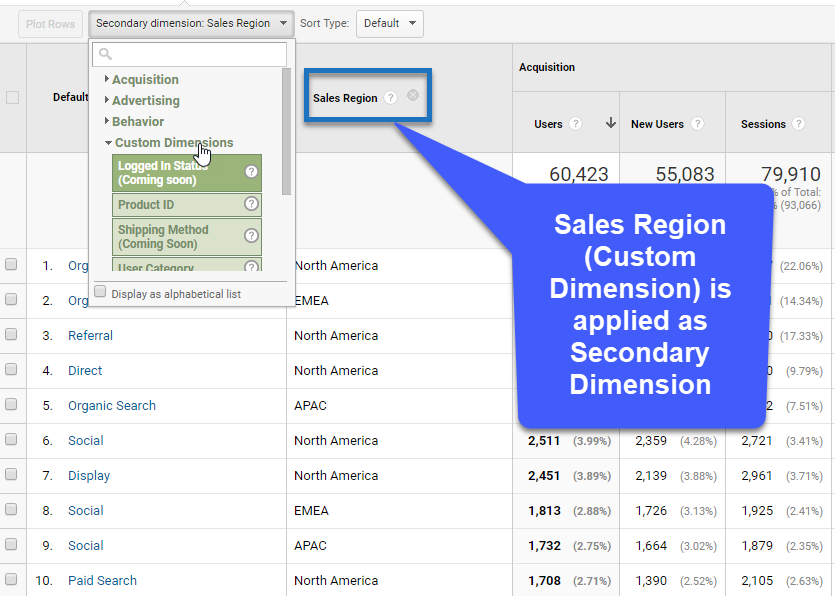The Best Guide To What Is A Secondary Dimension In Google Analytics
Wiki Article
The 45-Second Trick For What Is A Secondary Dimension In Google Analytics
Table of ContentsWhat Is A Secondary Dimension In Google Analytics Things To Know Before You BuyIndicators on What Is A Secondary Dimension In Google Analytics You Should KnowExcitement About What Is A Secondary Dimension In Google AnalyticsThe smart Trick of What Is A Secondary Dimension In Google Analytics That Nobody is Discussing
Its dimensions can be (but are not restricted to): Transaction ID Discount coupon code Most current website traffic resource, and so on. That event's personalized measurements could be: Login approach Individual ID, and so on.Hence custom dimensions are required. In Google Analytics, you will certainly not discover any kind of dimensions related specifically to online training courses.
9%+ of organizations using GA have absolutely nothing to do with programs. And that's why anything relevant specifically to on-line courses ought to be configured manually. Get In Custom-made Capacities. In this article, I will certainly not dive deeper right into custom measurements in Universal Analytics. If you intend to do so, read this guide.

The scope specifies to which events the measurement will apply. In Universal Analytics, there were 4 ranges: User-scoped custom measurements are used to all the hits of a user (hit is an event, pageview, and so on). If you send out Customer ID as a custom-made measurement, it will certainly be used to all the hits of that specific session As well as to all the future hits sent by that user (as long as the GA cookie remains the very same).
The Facts About What Is A Secondary Dimension In Google Analytics Revealed
For instance, you can send the session ID personalized measurement, and also also if you send it with the last occasion of the session, all the previous events (of the exact same session) will certainly obtain the worth (What Is A Secondary Dimension In Google Analytics). This is carried out in the backend of Google Analytics. measurement uses just to that specific event/hit (with which the measurement was sent out)
Even if you send numerous items with the exact same deal, each product might have various worths in their product-scoped custom-made dimensions, e. g.
Why am I telling you this? In Google Analytics 4, the session extent is no much longer offered (at least in personalized measurements). If you want to apply a measurement to all the events of a particular session, you must send out that dimension with every event (that can be done on the code degree (gtag) or in GTM).
The Buzz on What Is A Secondary Dimension In Google Analytics
It can be in a cookie, information layer, or somewhere else. From now on, custom dimensions are either hit-scoped or user-scoped (formerly understood as Customer Residences). User-scoped custom dimensions in GA4 job similarly to the user-scoped measurements in Universal Analytics yet with some differences: In Universal Analytics, a user-scoped custom-made dimension (set in the center of the user session) was related to EVERY occasion of the very same session (even if some event took place continue reading this prior to the dimension was established).Despite the fact that you can send custom-made item information to GA4, right now, there is no chance to see it in records properly. Hopefully, this will certainly be altered in the future. Or am I missing something? (allow me recognize). GA4 now sustains item-scoped personalized dimensions. At some point in the past, Google stated that session-scoped personalized measurements in GA4 would be available as well.
But when it comes to customized dimensions, this range is still not offered. As well as now, let's relocate to the second component of this post, where I will certainly show you exactly how to configure customized dimensions as well as where to find them in Google Analytics 4 reports. Let me begin with a basic introduction of the process, and then we'll take an appearance at an instance.

If you utilize it to primarily stream information to Big, Query and after that do the evaluation there, you can send out any type here of personalized parameters you desire, and they will be noticeable in Big, Query. You can just send out the event name, state, "joined_waiting_list" and afterwards include the criterion "course_name". And that's it.
How What Is A Secondary Dimension In Google Analytics can Save You Time, Stress, and Money.
In that case, you will need to: Register a parameter as a customized meaning Begin sending customized specifications with the events you want The order DOES NOT matter below. You must do that quite much at the same time. If you start sending out the criterion to Google Analytics 4 and also only register it as a customized dimension, say, one week later on, your records will certainly be missing that week of information (because the registration of a customized dimension is not retroactive).Every single time a site visitor clicks a menu item, I will certainly send an event and also 2 additional parameters (that I will certainly later register as personalized measurements), menu_item_url, and menu_item_name.: Food selection web link click tracking trigger problems differ on most internet sites (due to different click courses, IDs, and so on). Try to do your ideal to apply this instance.
Go to Google Tag Supervisor > Triggers > New > Simply Hyperlinks. By producing this trigger, we will certainly allow the link-tracking capability in Google Tag Manager.
Then go to your internet site as well as click any one of the menu web links. Really, click a minimum of two of them. Go back to the sneak peek mode, as well Get the facts as you need to start seeing Web link Click occasions in the preview mode. Click the initial Link, Click event and also most likely to the Variables tab of the preview setting.
Report this wiki page